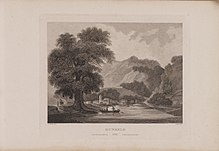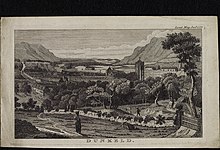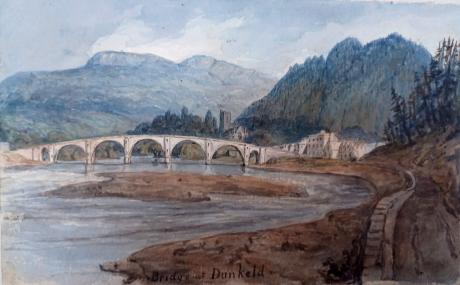inscribed "Bridge at Dunkeld" a page from an album inscribed in the frontispage "F W Staines 3 Uplands St Leonards on Sea"
Amelia Jackson, Nee Staines (1842 – 1925) and thence by descent
Dunkeld Bridge is a seven-arch bridge crossing the River Tay at Dunkeld, Perth and Kinross, Scotland. It carries the pedestrian and vehicle traffic of Bridge Street (the A923) and connects the parishes of Dunkeld and Dowally to the north and Little Dunkeld to the south. A Category A listed structure, it is 685 feet (209 m) long, 26.5 feet (8 m) wide and 54 feet (16 m) high. Its middle arch is 90 feet (27 m) wide, two others are 84 feet (26 m), two more are 74 feet (23 m) and the land-arches are 20 feet (6 m). The pontage was abolished in 1879. An impressive gateway into Dunkeld, measuring over 200m a consisting of seven arches which provide great views over the town and cathedral. Dunkeld Bridge was built by Thomas Telford in 1809, hence also being known as Telford’s Bridge. At the time, it was the only bridge across the Tay between Perth and Aberfeldy, a distance of 35 miles. It was constructed as part of his new route north to Inverness, replacing the earlier Military Road. This road has since become the A9.
The bridge was built between 1805 and 1809 by Thomas Telford. It cost £33,978.
The Tay is not only the longest river in Scotland at 117 miles, but it also carries the greatest volume of any river in the British Isles (more than twice as much water as any other river – approx. 2 x Thames plus the Trent).
Therefore, between the 16thC and 1809 the only options to get to Dunkeld from Perth and the south were either – cross the Bridge at Perth and come round via Meikleour and Caputh. This road entered Dunkeld down what is now Brae Street, and continued down through the Cross, along Cathedral street and north towards Tulliemet and Moulin hugging the slopes of Craigie Barns.
The orientation of Dunkeld was thus: East-West. The other option was the cross by way of a ferry (there were two – East ferry, crossing from roughly the Birnam Oak area, and the West ferry crossing from Inver into the grounds of Dunkeld House). These ferries were dangerous in high waters, and indeed there was a very bad accident with several lives lost in 1766.
The Government was aware of the problem and became keen to build a bridge.
A Bridge at Dunkeld would only be part of a wider look at road-building in Scotland, and in particular the route north into the Highland via the strategic point at Dunkeld. The Wade’s road from Dunkeld built in the 1720s was frankly past it, and so a new route north was envisioned. At the time, the Government worked on a private-public-partnership scheme to undertake such projects: the Government paying half and a local landowner/consortium paying the other. The landowner at Dunkeld was the 4th Duke of Atholl. The price was estimated at £15,000, and the Government stumped up around £7,500.
However, the costs spiralled out of control (where have we heard that one before) and finished up at around £40,000. The Government wouldn’t budge on their contribution, so the Duke has to cough up for the rest – hence the placing of tolls on the bridge.
The Government appointed the famous Scottish engineer Thomas Telford to design the bridge, which is both functional (the heaviest load he could have imagined crossing the bridge would be four horse and a cart, and yet it can carry a 40 ton lorry with a safety factor of over X2) and elegant. It is an arc rather than a hump-back, which was a revolutionary new design, and the Tay was ‘moved’ to allow the contruction of parts of the pillars.
With the building of the Bridge, Dunkeld got two new streets – Bridge Street and Atholl Street, and the alignment of the town turned to a South-North orientation. The road north out of Dunkeld was re-aligned and would evolve eventually into the A9. It would carry the bulk of the traffic into the Highlands until the New A9 by-pass was opened in 1977.
Aerial view of Dunkeld (left), the bridge and Little Dunkeld, looking east towards Meikleour
-
A commemorative plaque on the bridge marking the structure's bicentenary in 2009
-
Dunkeld, and a lantern on the bridge
-
Western view
-
Eastern view
Dunkeld is a town in Perth and Kinross, Scotland. The location of a historic cathedral, it lies on the north bank of the River Tay, opposite Birnam. Dunkeld lies close to the geological Highland Boundary Fault, and is frequently described as the "Gateway to the Highlands" due to its position on the main road and rail lines north. Dunkeld has a railway station, Dunkeld & Birnam, on the Highland Main Line, and is about 25 kilometres (15 miles) north of Perth on what is now the A9 road. The main road formerly ran through the town, however following modernisation of this road it now passes to the west of Dunkeld.
Dunkeld is the location of Dunkeld Cathedral, and is considered to be a remarkably well-preserved example of a Scottish burgh of the late seventeenth and early eighteenth centuries. Around twenty of the houses within Dunkeld have been restored by the National Trust for Scotland, who run a shop within the town. The Hermitage, on the western side of the A9, is a countryside property that is also a National Trust for Scotland site.
Over the centuries there have been several bridges linking Dunkeld with neighbouring Birnam, and the current bridge, designed by Thomas Telford and financed by the 4th Duke of Atholl, was completed in 1809.
The name Dùn Chailleann means Fort of the Caledonii or of the Caledonians. The 'fort' is presumably the hill fort on King's Seat, slightly north of the town (NO 009 430). Both these place-names imply an early importance for the area of the later town and bishop's seat, stretching back into the Iron Age.
Dunkeld (Duncalden and variants in early documents) is said to have been 'founded' or 'built' by Caustantín son of Fergus, king of the Picts (d. 820).This founding likely referred to one of an ecclesiastical nature on a site already of secular importance, and a Pictish monastery is known to have existed on the site. Kenneth I of Scotland (Cináed mac Ailpín) (843–58) is reputed to have brought relics of St Columba from Iona in 849, in order to preserve them from Viking raids, building a new church to replace the existing structures, which may have been constructed as a simple group of wattle huts. The relics were divided in Kenneth's time between Dunkeld and the Columban monastery at Kells, Co. Meath, Ireland, to preserve them from Viking raids.
The 'Apostles' Stone', an elaborate but badly worn cross-slab preserved in the cathedral museum, may date to this time. A well-preserved bronze 'Celtic' hand bell, formerly kept in the church of the parish of Little Dunkeld on the south bank of the River Tay opposite Dunkeld, may also survive from the early monastery: a replica is kept in the cathedral museum.
The dedication of the later medieval cathedral was to St Columba. This early church was for a time the chief ecclesiastical site of eastern Scotland (a status yielded in the 10th century to St Andrews). An entry in the Annals of Ulster for 865 refers to the death of Tuathal, son of Artgus, primepscop (Old Irish 'chief bishop') of Fortriu and Abbot of Dunkeld. The monastery was raided in 903 by Danish Vikings sailing up the River Tay, but continued to flourish into the 11th century. At that time, its abbot, Crínán of Dunkeld (d. 1045), married one of the daughters of Máel Coluim mac Cináeda (1005–34) and became the ancestor of later Kings of Scots through their son Donnchad (Duncan I) (1034–40).


The see of Dunkeld was revived by Alexander I (1107–24). Between 1183 and 1189 the newly formed diocese of Argyll was separated from that of Dunkeld, which originally extended to the west coast of Scotland. By 1300 the Bishops of Dunkeld administered a diocese comprising sixty parish churches, a number of them oddly scattered within the sees of St Andrews and Dunblane.
The much-restored cathedral choir, still in use as the parish church, is unaisled and dates to the 13th and 14th centuries. The aisled nave was erected from the early 15th century. The western tower, south porch and chapter house (which houses the cathedral museum) were added between 1450 and 1475. The cathedral was stripped of its rich furnishings after the mid-16th century Reformation and its iconoclasm. The nave and porch have been roofless since the early 17th century. They and the tower in the 21st century are in the care of Historic Environment Scotland.
Below the ceiling vault of the tower ground floor are remnants of pre-Reformation murals showing biblical scenes (c. 1490), one of very few such survivals in Scotland. The clearest to survive is a representation of the Judgement of Solomon. This reflects the medieval use of this space as the Bishop's Court. Within the tower are preserved fragments of stonework associated with the cathedral and the surrounding area, including a Pictish carving of a horseman with a spear and drinking-horn, and a number of medieval grave-monuments.
The cathedral museum is housed in the former chapter house and sacristy, on the north side of the choir. After the Reformation this chamber was used as a burial aisle by the Earls, Marquises and Dukes of Atholl, and contains a number of elaborate monuments of the 17th-early 19th centuries.
Most of the original town was destroyed during the Battle of Dunkeld when, on 21 August 1689, the 26th Foot (Cameronian Regiment), under Lieutenant William Cleland (who died in the clash), successfully fought the Jacobites shortly after the latter's victory at the Battle of Killiecrankie. Holes made by musket-ball strikes during the battle can still be seen in the east gable of the cathedral.
Dr George Smyttan FRSE HEIC (1789-1863) was born and raised in Dunkeld and retained links to Birnam all his life.
Dunkeld was partly in the parish of Caputh until 1891.
The High Street drill hall in Dunkeld was completed in 1900.
The alignment of the town was radically altered in 1809 by the building of a new stone bridge — Dunkeld Bridge — over the River Tay by Thomas Telford at the east end of the town, and the laying out of a new street (Bridge Street–Atholl Street) at right angles to the old alignment.

The rebuilt town of Dunkeld is one of the most complete 18th-century country towns in Scotland. Many of the harled (rough-cast) vernacular buildings have been restored by the National Trust for Scotland (NTS). The present street layout of the older part of town consists of a 'Y-shaped' arrangement, parallel with the River Tay, comprising a single street (Brae Street/High Street) sloping down from the east into the long 'V' of the market place, known as The Cross. Closes (lanes) leading off this main street give access to the backlands of the houses (a traditional arrangement in Scottish towns). On the site of the traditional mercat cross, the fanciful neo-Gothic Atholl Memorial Fountain was built in 1866, as a monument to George Murray, 6th Duke of Atholl (1814–64). The Fountain is notable for its heraldry and Masonic symbolism, the 6th Duke having been Grand Master of the Grand Lodge of Scotland, 1843–64.
At the west end of The Cross is The Ell Shop (NTS), built 1757, which takes its name from the iron ell (weaver's measure) fixed against one corner. This building is said to have been built on the site of the town's medieval hospital, dedicated to St George. At the north-west corner of the same row is the Duchess of Atholl Girls' School, erected 1853 in neo-Gothic style, designed by R & R Dickson. It is generally known as the Duchess Anne after its founder Anne Home-Drummond (1814–97), spouse of the 6th Duke of Atholl and Mistress of the Robes to Queen Victoria. The building is used for exhibition and other purposes, notably the popular annual Dunkeld Art Exhibition in summer.

The left arm of the 'Y' leads along Cathedral Street to the medieval cathedral, and the right arm (now largely blocked off) originally led to Dunkeld House, built by Sir William Bruce in 1676-84 for the 1st Marquis of Atholl. Demolished in 1827, this was one of Scotland's major 17th-century mansions. A neo-Gothic replacement was begun on the same site but never completed (no visible remains). The area around the cathedral was the original focus of settlement in Dunkeld in medieval (and doubtless earlier) times. Here stood the manses of the Cathedral clergy, with the Bishop's Palace to the west of the church.
Surrounding countryside

Dunkeld is situated in an area of Scotland marketed as Big Tree Country. The area is heavily wooded, and has some notable trees, including the Birnam Oak, believed to be the only remaining tree from the Birnam Wood named by Shakespeare in his play Macbeth:
MACBETH: I will not be afraid of death and bane, till Birnam forest come to Dunsinane.
— Shakespeare, Macbeth, Act 5, scene 3.
Other significant trees in the area include Niel Gow's Oak, the tree under which Niel Gow, a fiddler under contract to three of the Dukes of Atholl, composed many of Scotland's famous strathspeys and reels. It stands near Gow's home at Inver. The Parent Larch near Dunkeld cathedral is the sole survivor from a group of larches collected from the mountains of the Tyrol mountains in 1738, and which were the seed source for large-scale larch plantings in the local area.
Much of the countryside surrounding the town is designated as a national scenic area (NSA), one of 40 such areas in Scotland, which are defined so as to identify areas of exceptional scenery and to ensure its protection by restricting certain forms of development. The River Tay (Dunkeld) NSA covers 5,708 hectares (14,100 acres). Parts of the area also form part of the Tay Forest Park, a network of forests managed by Forestry and Land Scotland that are spread across the Highland parts of Perthshire. About 2 miles (3 kilometres) northeast of the town is the Loch of the Lowes nature reserve, managed by the Scottish Wildlife Trust.
There are many walks in the area. The 1,324 feet (404 m) summit of Birnam Hill (on Murthly Estate) lies 1 mile (2 km) south of the railway station and is easily ascended from there, or from a car park to the east. Newtyle (996 feet (304 m)) and Craigiebarns (900 feet (270 m)) are in the immediate vicinity, while Craig Vinean (1,247 feet (380 m)) is on the opposite side of the river, along with Birnam Hill.
Ossian's Hall of Mirrors is a folly located in the pleasure grounds known as The Hermitage, located close to Dunkeld. The site is owned by the National Trust for Scotland, and has walks in the wooded scenery surrounding the River Braan.
Its location on the middle section of the River Tay make it a hub for salmon and trout angling. A few miles downstream at Caputh, Georgina Ballantine landed the largest salmon ever recorded in Britain.
Dunkeld & Birnam Golf Club is located to the north of Dunkeld and overlooks Loch of the Lowes.
Across the Telford Bridge, the Birnam Highland games take place annually in Little Dunkeld.

The A9 through Dunkeld was bypassed by a new section of road in 1977. The town is now approximately one hour from Glasgow and Edinburgh, and two hours from Inverness, by car. There are regular bus and coach services to Birnam and Dunkeld along the A9, with long-distance coaches operated by Scottish Citylink. There is access by rail at Dunkeld & Birnam railway station on the Highland Main Line route between Perth and Inverness. Most services on the route extend to either Edinburgh Waverley or Glasgow Queen Street; on Sundays only a southbound train operated by the East Coast Main Line operator extends to London King's Cross via Edinburgh, although there is no corresponding northbound service from London. A daily (except Saturday) London service is offered by the overnight Caledonian Sleeper trains to and from London Euston.
Francis William Staines was the last of a family of merchants from the City of London. Not only was he a successful businessman but he possessed a large independent fortune, such that he could devote his time to the cultivation of his talents in music and art. He was a brilliant amateur violinist, and also loved to spend much of his time painting. His daughter Amelia and her mother accompanied Mr Staines as he travelled throughout the country finding subjects for his painting. One area of the country that they visited frequently was Scotland and the Lake District, and Amelia grew particularly fond of the dramatic landscape of the Fells. Skelwith Bridge with the view of the hills around it 43 was one of her father’s favourite scenes. He painted landscapes and maritime paintings , exhibited 11 works at the RA including views on the Italian Coast, address in London, Hastings and St Leonards on Sea Susssex.







